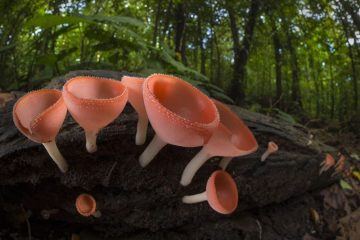Heidi Ledford in Nature:
 Minute fossils pulled from remote Arctic Canada could push back the first known appearance of fungi to about one billion years ago — more than 500 million years earlier than scientists had expected. These ur-fungi, described on 22 May in Nature1, are microscopic and surprisingly intricate, with filament-like structures. Chemical analyses suggest that the fossils contain chitin, a compound found in fungal cell walls. If that analysis holds up, it could reshape understanding of how fungi evolved and whether they might have facilitated the movement of plants onto land. But some researchers are not yet convinced that the finding is truly a fungus. “It looks to me as if there’s reason for believing it’s real at this point,” says Mary Berbee, a mycologist at the University of British Columbia in Vancouver, Canada. “But more data would be really useful.”
Minute fossils pulled from remote Arctic Canada could push back the first known appearance of fungi to about one billion years ago — more than 500 million years earlier than scientists had expected. These ur-fungi, described on 22 May in Nature1, are microscopic and surprisingly intricate, with filament-like structures. Chemical analyses suggest that the fossils contain chitin, a compound found in fungal cell walls. If that analysis holds up, it could reshape understanding of how fungi evolved and whether they might have facilitated the movement of plants onto land. But some researchers are not yet convinced that the finding is truly a fungus. “It looks to me as if there’s reason for believing it’s real at this point,” says Mary Berbee, a mycologist at the University of British Columbia in Vancouver, Canada. “But more data would be really useful.”
Palaeobiologist Corentin Loron at the University of Liège, Belgium, and his colleagues found the fossils while exploring a region of Arctic Canada called the Grassy Bay Formation. The team had to travel to the study site, nestled amid the area’s dramatic cliffs, by helicopter. Because the rocks there formed without exposure to high temperatures and pressures, the fossils within them are remarkably preserved, says palaeobiologist Emmanuelle Javaux, Loron’s adviser at the University of Liège. From there, the team painstakingly sectioned the fossils into thin sheets that could be analysed with an electron microscope. Those images revealed branched filaments ending in spheres. The filaments were divided into segments by septae, walls that are found in some modern fungi.
The fossils were discovered in billion-year-old rock, and the presence of chitin in the specimens further persuaded the researchers that they were preserved fungi that died a billion years ago. The team named the fungus Ourasphaira giraldae.
More here.
